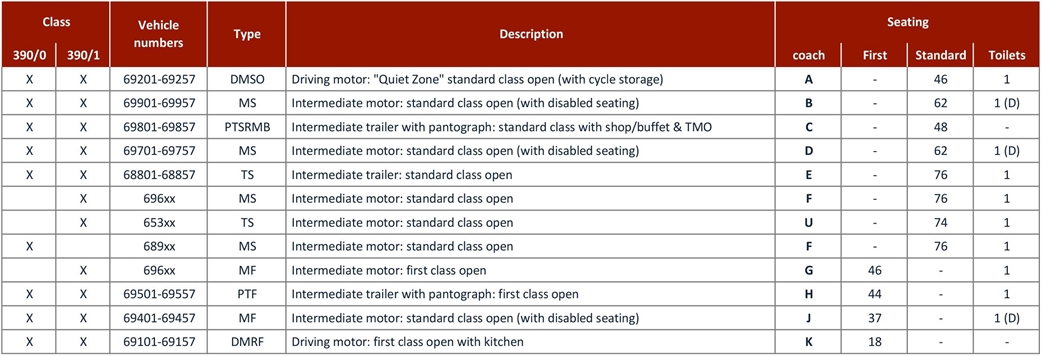
The InterCity West Coast franchise
News Mediarail.be
Long distance services > Great-Britain > Virgin Rail (Not official website)
> Les grandes lignes britanniques
> WCML - ECML - Cross Country - Virgin Rail - Stagecoach - Sleeper Caledonian
> ÖBB Railjet - CD Railjet - ÖBB Nighjet - CFF - Frecciabianca - PKP Intercity - Renfe
> Privés réguliers : NTV Italo - Thello - Leo Express - Regiojet - Westbahn - Flixtrain - Transdev - MTR - ILSA
> WCML - ECML - Cross Country - Virgin Rail - Stagecoach - Sleeper Caledonian
> ÖBB Railjet - CD Railjet - ÖBB Nighjet - CFF - Frecciabianca - PKP Intercity - Renfe
> Privés réguliers : NTV Italo - Thello - Leo Express - Regiojet - Westbahn - Flixtrain - Transdev - MTR - ILSA
Virgin CrossCountry was a train operating company in the United Kingdom operating the InterCity CrossCountry franchise from January 1997 until November 2007. Virgin CrossCountry operated some of the longest direct rail services in the United Kingdom but most avoided Greater London after 2003. All services called or terminated at Birmingham New Street.
The author:
Frédéric de Kemmeter
Railway signalling systems. I'm a rail observer for over 30 years. How has the railway evolved over the decades? Which futur for railways? That's what I'm analyzing and explaining.
Railway signalling systems. I'm a rail observer for over 30 years. How has the railway evolved over the decades? Which futur for railways? That's what I'm analyzing and explaining.

The InterCity West Coast franchise (1997 - 2019)
It is certainly the biggest, the most beautiful and the most emblematic franchise. The InterCity West Coast franchise includes the famous West Coast Main Line (WCML), which leads to the West Midlands, North Wales, and major cities such as Manchester, Liverpool, Edinburgh and Glasgow. An area of nearly 20 million potential customers, a brand spread throughout the territory, promised investments "that British Rail would never have achieved", as announced by the company Virgin Rail.
1997
The franchise - which is a temporary monopoly - begins in the early hours of March 7, 1997. The staff in new uniform does not appear until two days later. The duration of the contract is 15 years. The targets are very ambitious. When it won its tender, Virgin Rail agreed to repay government premiums totaling £ 1.25 billion over the 15 years of the franchise. Chris Green, managing director of Virgin Trains at that time, felt that this ambitious goal was within reach once Railtrack (now Network Rail), has completed the infrastructure upgrade and the fleet of 53 Pendolino from Fiat / GEC Alsthom will be in service.
No good train services without good infrastructure ...
The WCML is certainly a centrepiece in Great Britain. The line is electrified in 25kV on the 641 km from London-Euston to Glasgow and Edinburgh via Carlisle. In the late 1980s, the late British Rail had already proposed a plan called InterCity 250 that consisted of upgrading parts of the line to increase bend radius and to increase speed. The scheme, which would have seen the introduction of new rolling stock derived from the one developed for the electrification of the East Coast, was finally abandoned in 1992.
The modernization of the route was at the heart of the 15-year franchise agreement with Virgin Trains. This demonstrates the importance of tandem infrastructure/train and some limits of the separation model. Without infrastructure improvements, no competitor can improve punctuality, speed and quality of traffic. From the moment Virgin planned to "operate a world-class rail service", the infrastructure had to be upgrade to reach this goal. This is not the responsibility of the carrier but of Railtrack.
1997
The franchise - which is a temporary monopoly - begins in the early hours of March 7, 1997. The staff in new uniform does not appear until two days later. The duration of the contract is 15 years. The targets are very ambitious. When it won its tender, Virgin Rail agreed to repay government premiums totaling £ 1.25 billion over the 15 years of the franchise. Chris Green, managing director of Virgin Trains at that time, felt that this ambitious goal was within reach once Railtrack (now Network Rail), has completed the infrastructure upgrade and the fleet of 53 Pendolino from Fiat / GEC Alsthom will be in service.
No good train services without good infrastructure ...
The WCML is certainly a centrepiece in Great Britain. The line is electrified in 25kV on the 641 km from London-Euston to Glasgow and Edinburgh via Carlisle. In the late 1980s, the late British Rail had already proposed a plan called InterCity 250 that consisted of upgrading parts of the line to increase bend radius and to increase speed. The scheme, which would have seen the introduction of new rolling stock derived from the one developed for the electrification of the East Coast, was finally abandoned in 1992.
The modernization of the route was at the heart of the 15-year franchise agreement with Virgin Trains. This demonstrates the importance of tandem infrastructure/train and some limits of the separation model. Without infrastructure improvements, no competitor can improve punctuality, speed and quality of traffic. From the moment Virgin planned to "operate a world-class rail service", the infrastructure had to be upgrade to reach this goal. This is not the responsibility of the carrier but of Railtrack.
.jpg)
See also:
• My photos on Piwigo gallery
• My YouTube channel
• My blog with latest news
• Follow me on Twitter and LinkedIn
• My photos on Piwigo gallery
• My YouTube channel
• My blog with latest news
• Follow me on Twitter and LinkedIn
Partagez cette page
The initial cost estimate for the WCML project was £ 2.5 billion for track modernization and the introduction of a new mobile block signaling system for radio transmission. The bankruptcy of Railtrack in 2001 and its replacement by Network Rail in the aftermath of the Hatfield disaster led to a re-evaluation of the plans, while the cost of modernization was optimized. In the first five years, the cost of the project gradually increases to almost £9 billion, while at the same time the ambition of 225 km / h was raised to a modest speed of 200 km / h. Mobile block signaling, which is actually a draft of ETCS Level 3, was in fact too revolutionary and lacks experience. She is quickly abandoned. This double decline of ambition from the State allows Virgin to justify the renegotiations about payments to the State.
1997 - 2003 : trains service by push-pull trainsets
Virgin chooses from the start for frequent services, with trains that are not too long or heavy. The first trains used on the WCML had 9 cars with the following layout: DVT-FO-FO-FO-RFM-TSO-TSO-TSO-TSO-TSO, which means a pilot car, 3 First, a buffet car and 5 standard cars. Initially, some compositions still include old Mark II cars dating from the years 64-70, with a Mark III car buffet. The Mark II cars were engaged largely on the other CrossCountry franchise, but also on shorter distance WCML services, such as London-Birmingham (a notable Mark II stronghold), or as far away as Manchester. Class 86 locomotives were also limited to these shorter services, although Class 87s, or occasionally Class 90s, may occasionally appear at Birmingham-New Street.
The Mark IIIs were more prominent over the longer distances, sometimes with Class 86s. But it was mainly the Class 87s - built specifically for the Euston-Glasgow services - which remained the dominant form of traction on these services (photo -Dessous). The Mark III cars were mainly used on services to Glasgow, and then played an important role on services to Manchester and Liverpool. Conversely, the Class 90s were mostly used on services destined for Manchester and Liverpool, but could also be seen in Glasgow.
The Mark IIIs were more prominent over the longer distances, sometimes with Class 86s. But it was mainly the Class 87s - built specifically for the Euston-Glasgow services - which remained the dominant form of traction on these services (photo -Dessous). The Mark III cars were mainly used on services to Glasgow, and then played an important role on services to Manchester and Liverpool. Conversely, the Class 90s were mostly used on services destined for Manchester and Liverpool, but could also be seen in Glasgow.
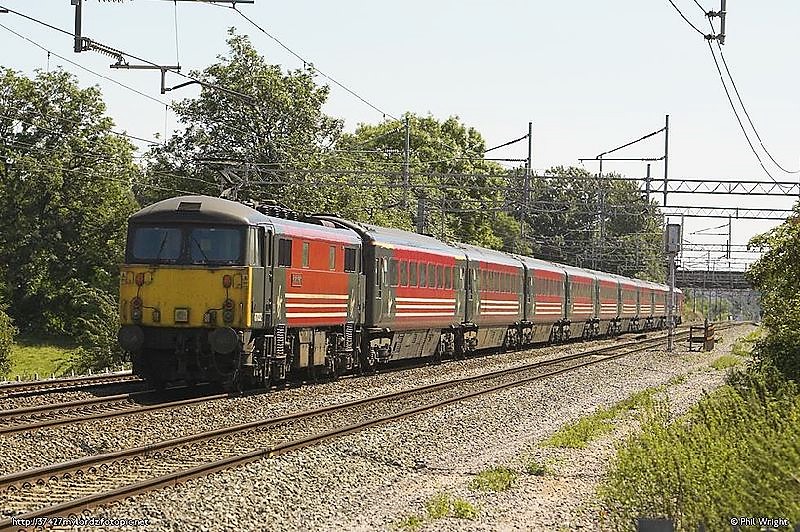
Class 87 with Virgin Mark III cars (photo Phil Wright via license wikipedia)
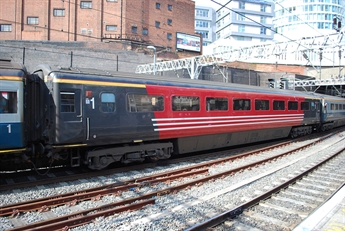
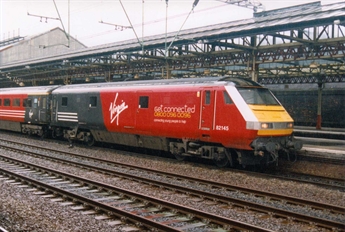
Examples above of the first years of the West Coast franchise, with the recovery of British Rail cars Mk 3a first class (FO 11027) and a driver car (82145) towed trains. Below, picture of a RFM 10237 Mk3A 'Buffet' (Steve Jones photos licensed under Flickr).
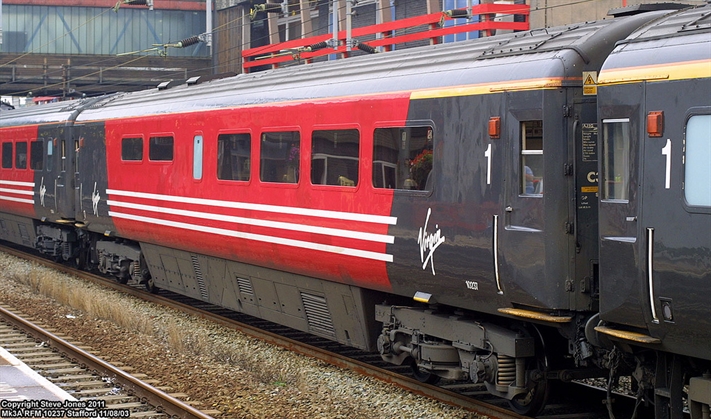
2004 : Pendolinos Class 390
Virgin, who already had experience through his eponymous airline, wanted to integrate airlines concepts in the british trains. That was the basis of the creation the design office in 1998 which designed specifications for a fast service for quick visits between London and the big cities of the North of Great Britain. But the train is always dependent on the infrastructure. The WCML improvement projects by Railtrack (at that time), seems to go to being above the realism on all the works and their costs. In 1999, Railtrack's estimate for the cost of infrastructure upgrading nearly trebled from £2·1bn to £5·8bn. The mobile block technology, a moment considered, and today quivalent to the ETCS level 3, was fortunately abandoned.
Attracting investors and back nearly £1.25bn in premiums to the British government, supposed a break of established practice. The Director Chris Green did not hesitate to declare the imperative of "creating a world class railway", without making it on the former public service operator: « British Rail would never have dared to think of doubling the business! ». Green recognized as being difficult to transpose the airline model on the train, even if « people were waitng for a service close to Virgin Atlantic ». Despite the old push-pull trainsets for the franchise start, the number of passengers had been extended by 40% over the first three years, confirming the policy of the group. But it became clear that Railtrack would not be able to boost online speed.
To achieve break in practices and significant improvements in travel time and comfort, Virgin envisaged a turnover rate of 47 services and a reliability of an incident every 50,000 miles (80,400km), a driving quality 30% higher than a push-pull train, and finally a maximum of 65dB inside trains. To overcome the shortcomings of Railtrack, Virgin has to opt for a tilting train and begins negotiations with several manufacturers. But who in Europe makes tilting trains and controls this technology?
Change of industrial culture
The Italian Fiat Ferroviaria wins the bid while the French firm Alstom is preparing to take over the only company in Europe that builds the ETR 450, ETR 460, ETR 500 and the S220 for Finland. A deal was agreed with the rosco Angel Train to acquire 57 trains finally ordered. Alstom faced a novelty: Virgin left the manufacturer "manage on his own" to provide trains that are operational every day according to the availability specifications required by the contract. An Alstom executive pointed out that this changed radically with the old 'subcontracting culture' that has always in practice with the SNCF! The industry should take the lead and offer a top-level train to different customers who, like Virgin, cames not from the railway world. A big challenge...
Attracting investors and back nearly £1.25bn in premiums to the British government, supposed a break of established practice. The Director Chris Green did not hesitate to declare the imperative of "creating a world class railway", without making it on the former public service operator: « British Rail would never have dared to think of doubling the business! ». Green recognized as being difficult to transpose the airline model on the train, even if « people were waitng for a service close to Virgin Atlantic ». Despite the old push-pull trainsets for the franchise start, the number of passengers had been extended by 40% over the first three years, confirming the policy of the group. But it became clear that Railtrack would not be able to boost online speed.
To achieve break in practices and significant improvements in travel time and comfort, Virgin envisaged a turnover rate of 47 services and a reliability of an incident every 50,000 miles (80,400km), a driving quality 30% higher than a push-pull train, and finally a maximum of 65dB inside trains. To overcome the shortcomings of Railtrack, Virgin has to opt for a tilting train and begins negotiations with several manufacturers. But who in Europe makes tilting trains and controls this technology?
Change of industrial culture
The Italian Fiat Ferroviaria wins the bid while the French firm Alstom is preparing to take over the only company in Europe that builds the ETR 450, ETR 460, ETR 500 and the S220 for Finland. A deal was agreed with the rosco Angel Train to acquire 57 trains finally ordered. Alstom faced a novelty: Virgin left the manufacturer "manage on his own" to provide trains that are operational every day according to the availability specifications required by the contract. An Alstom executive pointed out that this changed radically with the old 'subcontracting culture' that has always in practice with the SNCF! The industry should take the lead and offer a top-level train to different customers who, like Virgin, cames not from the railway world. A big challenge...
Two subcategories
At Alstom, the Pendolinos are part of the Avelia concept, « a flexible and interoperable passenger rail solution, running on conventional or high-speed lines, up to 250 km / h », says the company. It is therefore not a high-speed train as such, because the lack of upgrading of the WCML resulted in limiting the top speed of the line to 225km / h.
Two sub-categories are ordered:
- 22 trains Class 390/0 wtih 9 cars;
- 35 trains Class 390/1 with 11 cars.
At Alstom, the Pendolinos are part of the Avelia concept, « a flexible and interoperable passenger rail solution, running on conventional or high-speed lines, up to 250 km / h », says the company. It is therefore not a high-speed train as such, because the lack of upgrading of the WCML resulted in limiting the top speed of the line to 225km / h.
Two sub-categories are ordered:
- 22 trains Class 390/0 wtih 9 cars;
- 35 trains Class 390/1 with 11 cars.
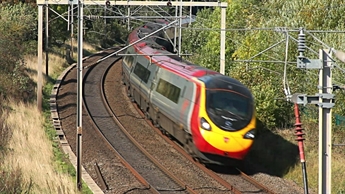
In July 2000, a first Class 390 was under intensive testing. The cars and a large part of the equipment were made in Italy, in Savigliano. Assembled in Washwood Heath (Birmingham), the Class 390s were the last rail product supplied on the former Birmingham Metro-Cammell site, which was subsequently closed as part of the rationalization of Alstom's production facilities.
A number of tests were carried out between Carnforth and Carlisle on a section of the line known as the "Test Site" A. The line was specially prepared for the "Enhanced Permitted Speed" tests. The tests were usually held on Saturday nights and were sometimes combined with a Class 221 (221101) unit, as the availabilities of WCML for testing were rather rare. At the sametime, several driver training courses also undertaken. The fleet was commissioned in mid-2002 to coincide with the opening of the 2002 Commonwealth Games in Manchester. The tilt system remains still inactive. In 2004, the units had begun operating to Glasgow Central and by the end of the summer, all services north of Preston were operated by Class 390 trains, that was the final point of the operation of the pulled trains. The British made a jump in the modern railways...
>>> See technical details on Pendolino Class 390
Marketing
Meanwhile, Virgin is refining his marketing plan. Chris Green noted that there was no customer service or operations manager for the west coast. He appointed Brenda Klug as Executive Director, Customer Service. Green described her as "an inspired leader who introduced a new style of professionalism" into her team, which included 35 customer service managers and 400 'train managers'. To achieve its customer service objectives, Virgin has developed six "service strategies" that the company wishes to apply to all of its businesses. These include security and reliability "Japanese way" and a "memorable customer service". Chris Green sums it up by "careful attention to details", which translates as "the goal is to spend a boring day when everything goes well". He also cites audio entertainment projects at each seat, as well as a free breakfast for every first-class passenger, as well as drinks and snacks throughout the day. Efficiency from the world of airliners...
The table below shows the 2015 Pendolino car classification:
A number of tests were carried out between Carnforth and Carlisle on a section of the line known as the "Test Site" A. The line was specially prepared for the "Enhanced Permitted Speed" tests. The tests were usually held on Saturday nights and were sometimes combined with a Class 221 (221101) unit, as the availabilities of WCML for testing were rather rare. At the sametime, several driver training courses also undertaken. The fleet was commissioned in mid-2002 to coincide with the opening of the 2002 Commonwealth Games in Manchester. The tilt system remains still inactive. In 2004, the units had begun operating to Glasgow Central and by the end of the summer, all services north of Preston were operated by Class 390 trains, that was the final point of the operation of the pulled trains. The British made a jump in the modern railways...
>>> See technical details on Pendolino Class 390
Marketing
Meanwhile, Virgin is refining his marketing plan. Chris Green noted that there was no customer service or operations manager for the west coast. He appointed Brenda Klug as Executive Director, Customer Service. Green described her as "an inspired leader who introduced a new style of professionalism" into her team, which included 35 customer service managers and 400 'train managers'. To achieve its customer service objectives, Virgin has developed six "service strategies" that the company wishes to apply to all of its businesses. These include security and reliability "Japanese way" and a "memorable customer service". Chris Green sums it up by "careful attention to details", which translates as "the goal is to spend a boring day when everything goes well". He also cites audio entertainment projects at each seat, as well as a free breakfast for every first-class passenger, as well as drinks and snacks throughout the day. Efficiency from the world of airliners...
The table below shows the 2015 Pendolino car classification:
Two comforts :
- Class 390/0 : 99 places in first class, 370 places in standard class, making a total of 469 places;
- Class 390/1 : 145 places in first class, 444 places in standard class, making a total of 599 places;
To offer both comfort and convenience, the Pendolino has many amenities and innovations, such as a snack-shop instead of the traditional dining car and the extensive presence of visual information systems for passengers, installed at ends and on the doors themselves.
- Class 390/0 : 99 places in first class, 370 places in standard class, making a total of 469 places;
- Class 390/1 : 145 places in first class, 444 places in standard class, making a total of 599 places;
To offer both comfort and convenience, the Pendolino has many amenities and innovations, such as a snack-shop instead of the traditional dining car and the extensive presence of visual information systems for passengers, installed at ends and on the doors themselves.
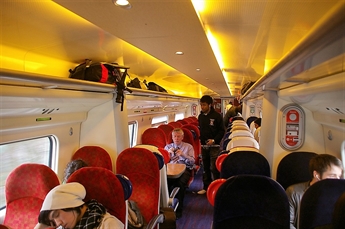
Classe 'Standard' de la rame 390050 (photo Matt Buck via license flickr)
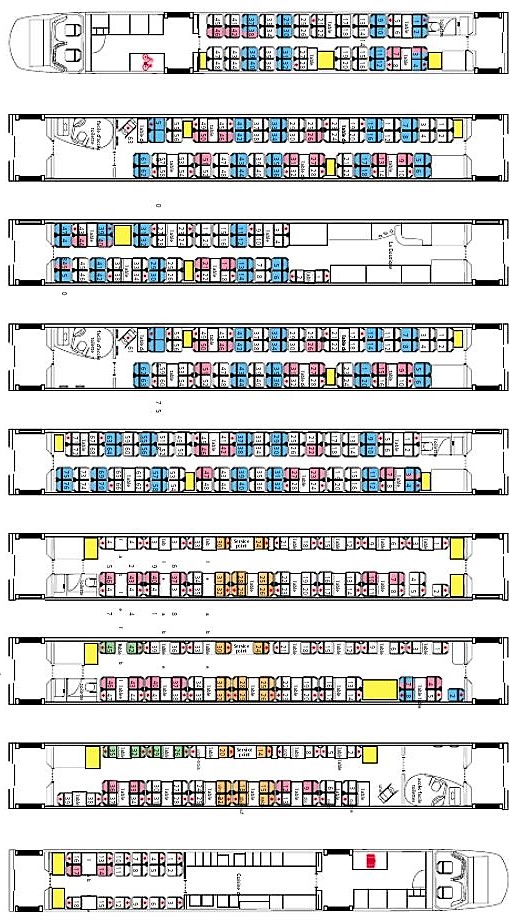
Coach A (voiture-pilote)
46 Standard places including 12 face to face.
Coach B
62 Standard places including 20 face to face and toilet for disable.
46 Standard places including 12 face to face.
Coach B
62 Standard places including 20 face to face and toilet for disable.



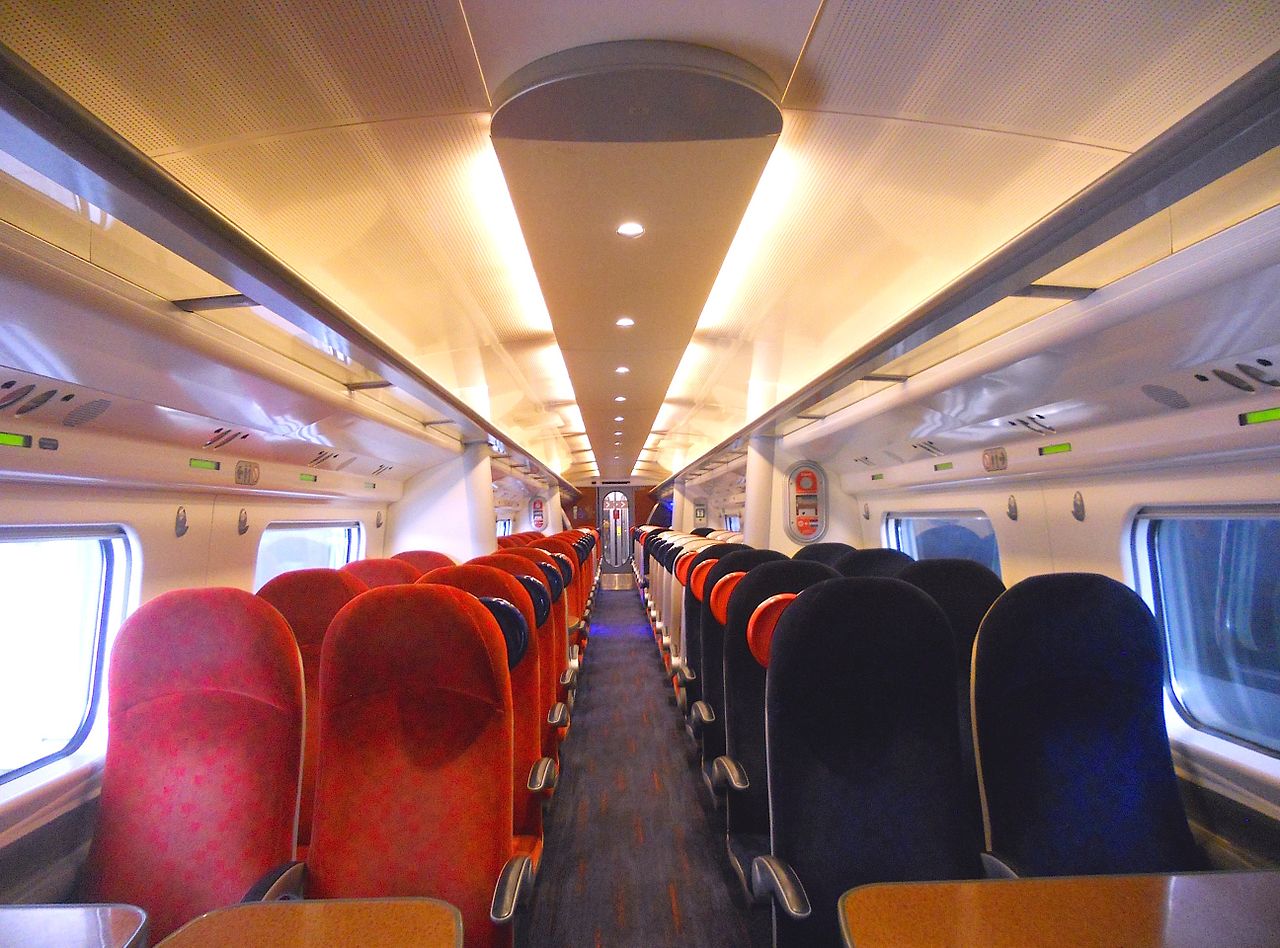


'Standard' class from trainset 390001 (photo Peter Skuce via license wikipedia)
The disappearance of the restaurant in favor of a coffee corner and drink dispensers is the evolution of time, but also the concern to keep a maximum of places to meet the demand. Virgin offers in this space theirs brekkies, hot and cold sandwiches and snacks, sweet or savory vegetarian or even vegan!
Coach C
48 Standard places including 20 face to face. Shop corner + drink dispensers. Coach with pantographe.
48 Standard places including 20 face to face. Shop corner + drink dispensers. Coach with pantographe.

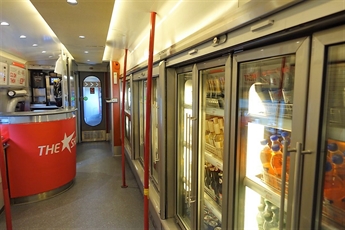
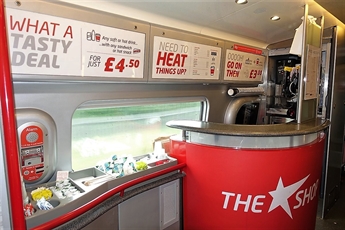
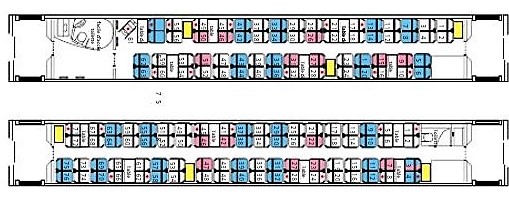
Coach D
62 Standard places including 20 face to face and toilet for disable
Coach E + F
76 Standard places including 20 face to face, in each coach.
62 Standard places including 20 face to face and toilet for disable
Coach E + F
76 Standard places including 20 face to face, in each coach.
Trainsets Class 390/1 with 11 coaches have in addition a non-motorised coach U with 74 Standard places.
We entry now in first class. Trainsets Class 390/1 with 11 coaches have in addition a motorised coach G with 46 places in First.
We entry now in first class. Trainsets Class 390/1 with 11 coaches have in addition a motorised coach G with 46 places in First.

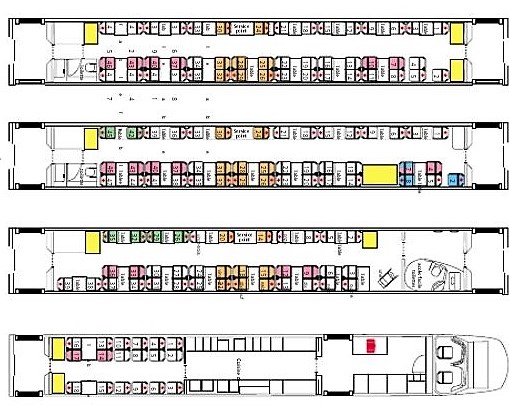
Coach H
44 places in First, all face to face with table and seats deployed with 2+1 confi-guration. Coach with pantogra-phe.
Coach J
37 places in First, all face to face with table and seats deployed with 2+1 confi-guration.
Coach K (voiture pilote)
18 places in First and seats deployed with 2+1 confi-guration. Kitchen and luggages
44 places in First, all face to face with table and seats deployed with 2+1 confi-guration. Coach with pantogra-phe.
Coach J
37 places in First, all face to face with table and seats deployed with 2+1 confi-guration.
Coach K (voiture pilote)
18 places in First and seats deployed with 2+1 confi-guration. Kitchen and luggages

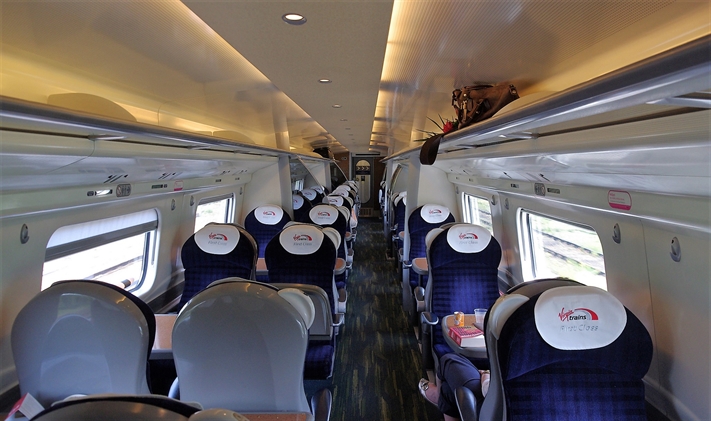
First class of trainset 390050 with seats in configuration 2+1 and tables (photo Matt Buck via license flickr)
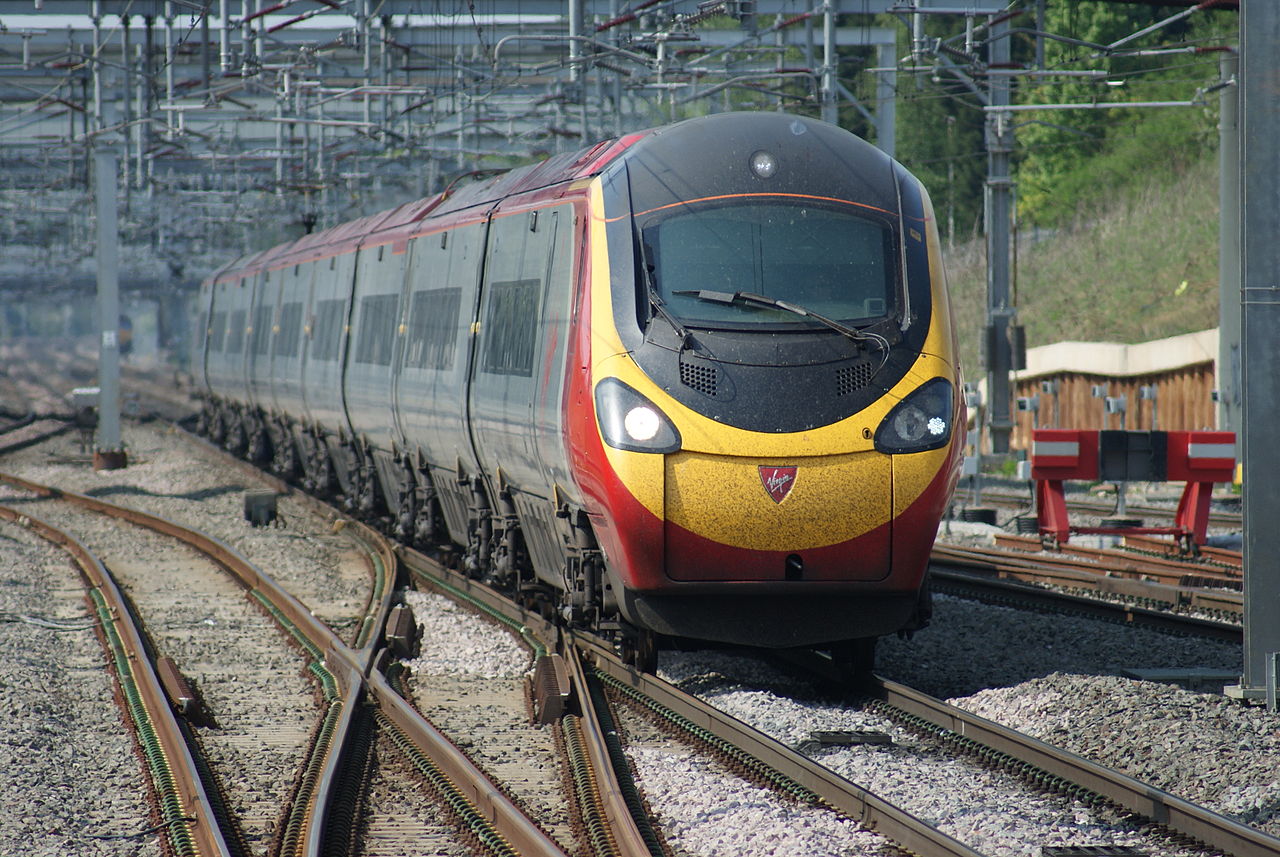
First trainset 390001 with nine coaches, passing Milton Keynes in April 2011 (photo Nicholas Hair via license wikipedia)








-WEc780af7f81.png)


